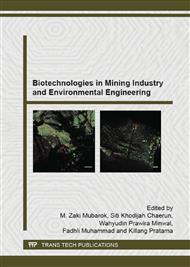p.32
p.36
p.40
p.45
p.50
p.55
p.59
p.63
p.67
Thermodynamic Modelling of Geo-Biometallurgical Oxidation of Sulfide Ores
Abstract:
Heap bioleaching of sulfide ores (geotechnology) simulates naturally occurring processes when sulfides convert to oxides. This process is environmentally-friendly. Gold-bearing sulfide ore from a Russian deposit was studied. The samples were composed of quartz (38-48%), feldspars (22-24%) and micaceous minerals (18-21%). Carbonates occurred as ankerite, calcite, dolomite and siderite. The host minerals were pyrite (2.2-2.3%) and arsenopyrite (1.2-1/7%). The grade of gold was 1.6-2.0 g/t. Russian software package Selector was used to develop the model. Thermodynamics of the reaction pathway for the conversion of the gold-bearing sulfide ore in H2SO4 environment with and without using bacteria was calculated. Phases and their components which are able to form in these given conditions were selected during modeling. Modeling of irreversible evolution of the rocks caused by bacteria was carried out in the three reservoir system. They are interconnected by the flows of three movable phases: gases, solid phase and liquid phase. In this case, the composition of the solutions which were obtained under steady state conditions without bacteria and metastable equilibrium using bacteria can be compared. Bacterial oxidation occurs under acidic conditions. Oxidation without using bacteria occurs under more alkaline conditions. Bacteria increase the rate of sulfides oxidation and retard the formation of mixed-layer aluminum silicates (illites, montmorillomonites) and carbonates (magnesian calcite). It was found that bacteria have the potential to achieve the required destruction of sulfides in favorable environment. Bacteria make the rate of sulfide oxidation higher. In the presence of bacteria, the rate of aluminosilicates oxidation is slower compared to the conditions without using bacteria. Mineralogical analyses of the leach products confirmed this. Results show that thermodynamic approach can be successfully used for the modeling of bacterial-oxidation circuits and geology of the rocks and ores.
Info:
Periodical:
Pages:
50-54
Citation:
Online since:
November 2015
Keywords:
Price:
Сopyright:
© 2015 Trans Tech Publications Ltd. All Rights Reserved
Share:
Citation:


